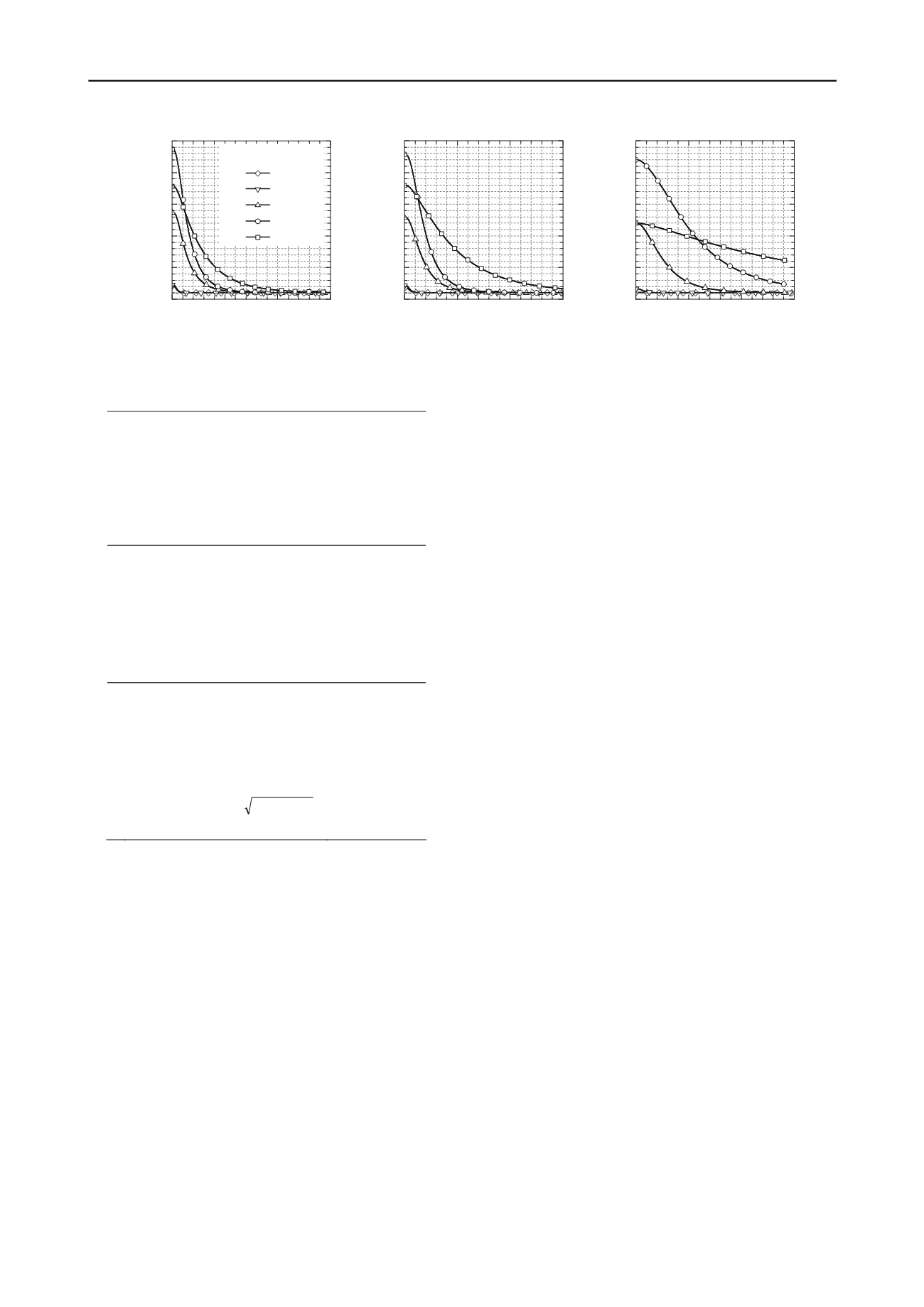
372
Proceedings of the 18
th
International Conference on Soil Mechanics and Geotechnical Engineering, Paris 2013
Proceedings of the 18
th
International Conference on Soil Mechanics and Geotechnical Engineering, Paris 2013
Table 1. Soil parameters used in the numerical simulation
.
Elasto-plastic parameters
Compression index
~
0.100
Swelling index
~
0.011
Critical state constant
M
1.46
Intersect of NCL
N
(
v
at
q
=0,
p
’=98.1kPa)
1.570
Poisson’s ratio
v
0.300
Evolution parameters
Degradation parameter of
soil structure
a
(
b
=
c
=1.0)
see
Fig.5
Degradation parameter of
overconsolidated state
m
0.030
Evolution parameter of
b
r
1.00
Limit of rotation
m
b
0.001
Initial conditions
Initial specific ratio
v
0
=1+
e
0
1.637 (
D
=80%)
1.536 (
D
=85%)
1.457 (
D
=90%)
Initial degree of structure 1/
R
0
*
see
Fig.5
Initial overconsolidation ratio 1/
R
0
see
Fig.5
Initial anisotropy
)
(/
0 0
32
0.01
Initial mean effective stress
p
0
’
9.80
(kPa)
an intercept of normal consolidation line
N
. Although soil
structure degradation parameters
a
,
b
and
c
are material
coefficients,
b
=
c
=1.0 is adopted in this analysis for simplicity.
The values for initial specific volumes
v
0
are determined as the
representative values from the specimens with a 10% initial
water content. Compression index
is obtained from the
oedometer tests, while critical state constant
M
and swelling
index are determined from the typical triaxial test results.
~
~
In each simulation, the initial effective stress
0
is 9.8kPa
and the isotropic consolidation is 100kPa; then the following
undrained shearing is numerically performed.
p
In general, the simulation explains the triaxial test results
well. Namely, basic parameters are used in common for all
cases. Only the parameters for the soil structure are changed in
order to reasonably explain the effects of the initial water
content and the degree of compaction on the shear behavior.
Therefore, the assumption that the initial water content of the
specimen leads to generation of a high soil structure is
considered to be valid.
Figure 5 illustrates the history of 1/
R
*
, which describes
how the soil structure deteriorates with an increasing the shear
strain
s
. In all the analytical cases, the degrees of soil structure
1/
R
*
gradually decrease and come closer to 1.0. Here, 1/
R
*
=1.0
means the disappearance of the soil structure. Since 1/
R
0
*
and
a
are assumed in this analysis, the 1/
R
*
and
s
relations are kinds
of installed functions, as shown in Figure 5. Using these
relations dor the soil structure, the triaxial test results can be
simulated well.
0
5
10
15
0
5
10
15
20
25
Initial water content
0%
3%
5%
10%
14%
1/
R
*
s
(%)
0
5
10
15
0
5
10
15
20
25
1/
R
*
s
(%)
0
5
10
15
0
5
10
15
20
25
1/
R
*
s
(%)
Figure 5. Degradation of degree of soil structure with increasing shear strain.
(c)
D
= 90%
(b)
D
= 85%
(a)
D
= 80%
5. SUMMARY
When performing triaxial tests using specimens consisting of
reconstructed gravel-mixed sand, the initial water content of the
sample during the specimen preparation greatly influences the
results of the tests. Various degrees of soil structures were
generated with various values of sample suction in the specimen
preparation. Although the specimens were fully saturated before
the tests, the soil structure generated by the compaction under
unsaturated conditions was probably maintained during the
triaxial tests.
The numerical simulation conducted in this study with the
SYS Cam-clay model, which can describe the effects of the soil
structure on the mechanical characteristics of soils, has verified
the reason for the difference in the shear behavior of the gravel-
mixed sand due to the difference in the initial water contents.
By increasing the initial water content until the optimum water
content is reached, a higher soil structure seems to be generated
in the specimen. On the other hand, the specimen reconstituted
by the lower initial water content sample has a lower soil
structure and easily loses it. By incorporating the above-
mentioned concept, the complicated test results for the relation
between the soil structure and the initial water content can be
explained well.
In practice, when the triaxial tests are performed using
reconstituted sand specimens, a dry deposition method is
usually adopted for the specimen preparation for convenience.
However, it is difficult to generate the soil structure in the
specimen with dry sand. Therefore, the triaxial test results using
reconstituted specimens, made by the dry deposition method,
may not express the real behavior of earth structures.
6 ACKNOWLEDGEMENTS
The authors would like to express their sincere thanks to Dr.
Noda, a professor at Nagoya University, for his useful advice on
the numerical simulation performed in this study.
7 REFERENCES
Ishihara K. 1993. Liquefaction and Flow Failure during Earthquakes,
Géotechnique
, 43 (3), 351-451.
Asaoka A., Noda T., Yamada E., Kaneda K. and Nakano M. 2002 An
elasto-plastic description of two distinct volume change
mechanisms of soils,
Soils and Foundations
, 42 (5), 47-57


